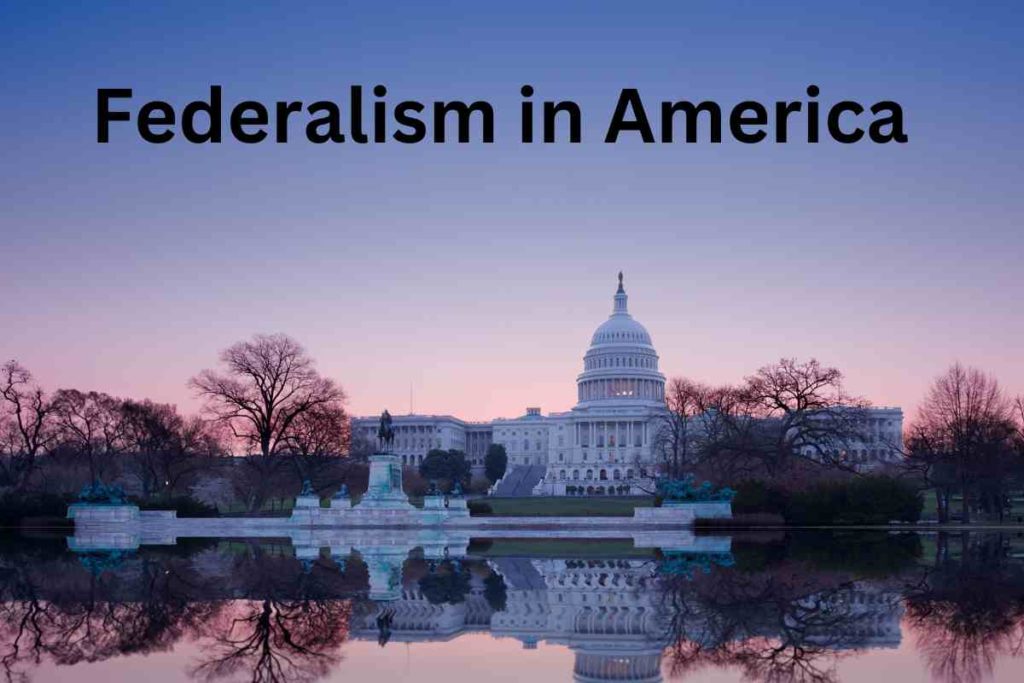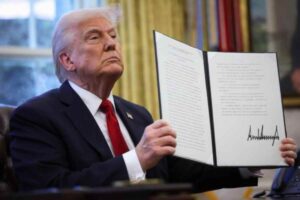Federalism in America: Balancing Power between National and State Governments

Federalism in America is the bedrock upon which the United States Constitution is built, defining the power distribution between the federal government and individual state governments. This system allows both levels of government to operate directly with the citizens, contributing to the dynamism and flexibility of the American political framework. This blog post delves into the concept of Federalism, its origins, and its influence on U.S. governance.
Understanding Federalism in America
The Definition of Federalism: Federalism is a political system where power is divided between a central (national) government and a regional (state or provincial) government. This division of powers is typically outlined in a nation’s constitution. In a federalist system, both the national government and the regional governments maintain direct jurisdiction over their citizens, have their own set of laws, and are given certain responsibilities and powers. Federalism in America is designed to prevent the concentration of power in a single central authority and to allow for a level of regional autonomy, thus safeguarding against potential tyranny. It also facilitates governance by allowing laws and policies to be tailored to the unique needs of individual regions.
The Role of Federalism:
Federalism is like the heartbeat of a nation, pumping life into the system by maintaining a healthy equilibrium between central and regional powers. It’s the diplomatic mediator, balancing the scales of power, ensuring that neither the national government nor the individual states dominate. At its core, federalism in America is a champion of diversity and local identity. It empowers regional governments to tailor their laws and policies to reflect the unique needs and aspirations of their communities, making governance feel more personal and responsive. Simultaneously, it vests the national government with authority to weave these distinct threads into a cohesive tapestry, ensuring national unity and consistency, particularly in areas such as defense and foreign affairs. It’s a bit like a symphony orchestra – each instrument plays its own part, but all come together under the guidance of the conductor to create a harmonious whole. Additionally, federalism in America opens doors for political participation at various levels and fosters innovation by allowing states to experiment with policies – a true manifestation of the “laboratories of democracy.” In essence, federalism serves as the delicate dance between unity and diversity, orchestrating a powerful performance of democratic governance.
The Origins of Federalism
The Framers and the Constitution:
When the Framers sat down to draft the U.S. Constitution, they embarked on a monumental task. These visionaries, with their sharp quills and sharper minds, sought to birth a new nation from the ashes of revolution. The challenge? To create a government that was strong enough to maintain order and protect the people yet restrained enough to prevent tyranny. They were akin to skilled architects, meticulously designing the blueprint for a resilient structure of governance. Their brilliant solution was the Constitution, a masterpiece of political engineering. They ingeniously introduced the concept of federalism in America, delicately balancing powers between the national and state governments. The resulting framework allowed for a robust central authority while ensuring that individual states retained a substantial degree of autonomy. Their work was a careful dance of compromise, negotiation, and foresight that reflected a profound understanding of human nature and societal needs. Today, their legacy endures in the Constitution, the resilient foundation upon which the United States stands, a testament to the vision and wisdom of the Framers.
Federalist vs. Anti-Federalist Views: Picture this: it’s the late 18th century, and the ink on the U.S. Constitution is barely dry. Two camps emerge, each with a distinct vision for the newly minted nation – the Federalists and the Anti-Federalists. The Federalists, a group of visionaries including the likes of Alexander Hamilton and James Madison, ardently supported the newly proposed Constitution. They see a strong central government as the lighthouse guiding the nation through the stormy seas of international politics and economic challenges. The Anti-Federalists, on the other hand, including luminaries like Patrick Henry and Samuel Adams, voiced concerns about this new powerhouse of a central government. They fear that it might overshadow the states, causing the flame of individual liberties to flicker and fade. This ideological tug-of-war sparks heated debates and impassioned speeches, igniting the crucible in which the future of the nation is forged. The result? The Bill of Rights, a nod to the Anti-Federalist’s concerns, became a part of the Constitution the Federalists championed. This epic clash of ideas shaped the contours of the U.S. Constitution and, with it, the future of the nation. It’s a testament to the power of diverse perspectives in sculpting the bedrock of American democracy.
The Evolution of Federalism
Dual Federalism (1789-1933): Imagine a layered cake. Neatly divided, each layer has its distinct flavor, yet all contribute to the delightful whole. This is a fitting metaphor for Dual Federalism, a period spanning from 1789 to 1933 in American history. During this time, the national government and the states functioned like separate layers of a cake, each performing their tasks independently without much overlap. The national government handled responsibilities like foreign affairs, defense, and interstate commerce, while the states managed domestic affairs, such as education, local law enforcement, and infrastructure development. This clear division of labor allowed both levels of government to excel in their respective domains, a bit like specialists in a team. But just as importantly, it preserved the sense of autonomy and identity of individual states, serving as a testament to the nation’s diversity. This era of Dual Federalism was a significant chapter in America’s evolving story of governance, offering valuable insights into the power dynamics and interplay between national and state governments.
Cooperative Federalism (1933-1964): Let’s rewind back to the 1930s. The U.S. was in the grip of the Great Depression, facing economic challenges of an unprecedented scale. This period triggered a shift in the dynamics of federalism – like a dance changing tempo mid-song. Enter the era of Cooperative Federalism in America, which lasted from 1933 to 1964. Picture the layered cake of Dual Federalism transforming into a marble cake, where the swirls of different flavors intertwine. Similarly, the clear-cut boundaries between the roles of national and state governments began to blur. They started working more collaboratively, sharing responsibilities to address the complex problems of the time. This was particularly evident during President Franklin D. Roosevelt’s New Deal, a series of federal programs aimed at economic recovery. Both levels of government had to roll up their sleeves, intertwine their efforts, and cooperate extensively to pull the nation out of the economic quagmire. This era of Cooperative Federalism exemplifies the flexibility of the American federal system and its ability to adapt in response to national crises.
New Federalism (1964-Present): Fast forward to the 1960s, an era marked by remarkable change and transformation. It’s during this time that a new rhythm begins to beat within the heart of federalism in America. This era, known as New Federalism and continuing till today, is like a dance where the lead occasionally switches between partners. Initially championed by presidents like Richard Nixon and Ronald Reagan, New Federalism advocates for a re-calibration of powers, nudging them back towards the states. The intent is akin to a conductor fine-tuning the orchestra, striving for a harmonious balance. This era sees states regaining some control, asserting their rights to manage their affairs, and developing policies that best suit their citizens’ needs. It’s as if the states are the artists, each painting their canvas with their unique hues, while the federal government provides the frame that holds the pieces together. This ongoing phase of New Federalism underscores the dynamic nature of American governance, reflecting the ebb and flow of power between national and state governments in response to the changing needs of society.
Key Concepts in Federalism
Enumerated, Reserved, and Concurrent Powers: Imagine a family kitchen. There’s a list on the fridge, splitting up the chores. Some tasks are assigned to the parents (like cooking the meals), some to the kids (like setting the table), and some they do together (like cleaning up after dinner). This is somewhat like how powers are divided in the American federal system. The chores for the federal government – things like conducting foreign policy, coining money, and regulating interstate commerce – are the enumerated powers listed in the U.S. Constitution. The tasks left for the states – such as conducting elections, establishing local governments, and regulating intrastate commerce – are the reserved powers kept in their domain by the 10th Amendment. Then there are the concurrent powers – tasks that both the federal and state governments can perform. These include things like taxing, borrowing money, and enforcing laws. This division of enumerated, reserved, and concurrent powers is like a chore list for the nation, helping to maintain a tidy balance between the federal and state governments, each with their distinct roles and shared responsibilities.
The Supremacy Clause and Preemption: Think of the U.S. Constitution as the rulebook for the game of American governance. At the heart of this rulebook, there’s a clause known as the Supremacy Clause. It’s kind of like the golden rule, declaring that federal laws take precedence over state laws when there’s a conflict between the two. Imagine a game of cards where a certain card is deemed the “trump card,” overriding all others – that’s the role federal law plays under the Supremacy Clause. Then there’s the concept of preemption. It’s like the federal government’s ‘power play’, stepping in to regulate a specific area fully, leaving no room for the states. Consider it as a clear boundary drawn on the playground, where only one team can play. Both the Supremacy Clause and preemption ensure that the ‘game’ of governance is played smoothly, with clarity about which rules apply when the federal and state laws seem to collide. They serve as navigational tools, guiding the ship of state through the potentially choppy waters of federal-state relations.
The Commerce Clause and Federal Power: Let’s take a journey back in time to the days of the Founding Fathers. As they crafted the U.S. Constitution, they included a powerful tool in their toolkit – the Commerce Clause. Envision it as a major highway connecting the states, with the federal government at the helm, regulating the traffic of trade and commerce. This clause gives Congress the power to regulate commerce with foreign nations, among the states, and with the Native American tribes. Over time, it has become a cornerstone of the expansion of federal power, akin to a river that’s broadened its course. It’s been interpreted to cover a wide array of economic activities, from labor relations to environmental regulations. In essence, the Commerce Clause is like a potent lever, one that the federal government can pull to influence a myriad of social and economic issues, making it a key player in the arena of federalism in America. This powerful tool underscores the dynamic nature of federal-state relations, demonstrating the adaptability of the Constitution to the changing landscape of the nation.
Federalism in Contemporary Society
Modern Challenges to Federalism: Let’s take a journey back in time to the days of the Founding Fathers. As they crafted the U.S. Constitution, they included a powerful tool in their toolkit – the Commerce Clause. Envision it as a major highway connecting the states, with the federal government at the helm, regulating the traffic of trade and commerce. This clause gives Congress the power to regulate commerce with foreign nations, among the states, and with the Native American tribes. Over time, it has become a cornerstone of the expansion of federal power, akin to a river that’s broadened its course. It’s been interpreted to cover a wide array of economic activities, from labor relations to environmental regulations. In essence, the Commerce Clause is like a potent lever, one that the federal government can pull to influence a myriad of social and economic issues, making it a key player in the arena of federalism in America. This powerful tool underscores the dynamic nature of federal-state relations, demonstrating the adaptability of the Constitution to the changing landscape of the nation.
Federalism and the COVID-19 Pandemic: Picture the year 2020 – a year that brought the world to its knees with the onset of the COVID-19 pandemic. For federalism, it was a stress test like no other. Visualize federalism as a well-oiled machine tasked with coordinating a nationwide response to this public health crisis. The pandemic brought to light the strengths and weaknesses of the federal system in a unique way. The federal government had to grapple with orchestrating a cohesive national strategy for testing, vaccine distribution, and financial relief, akin to a conductor trying to harmonize a complex symphony. Meanwhile, states were on the frontline, tailoring their responses to local conditions and resources, like improvising musicians adjusting their notes to the rhythm of the moment. The crisis also underscored the need for cooperation, as the federal and state governments had to coordinate their efforts to combat the virus effectively. The COVID-19 pandemic, thus, served as a profound reminder of the intricate dance of federalism, where the steps of both federal and state governments must be in sync to effectively navigate national crises.
Conclusion
As we navigate the complexities of the 21st century, Federalism continues to play a critical role in shaping our governance. The system’s flexibility allows us to adapt and evolve, maintaining a delicate balance between unity and diversity, national direction, and local control. It is a testament to the enduring wisdom of the framers of the Constitution and their commitment to creating a robust and flexible system of government.







